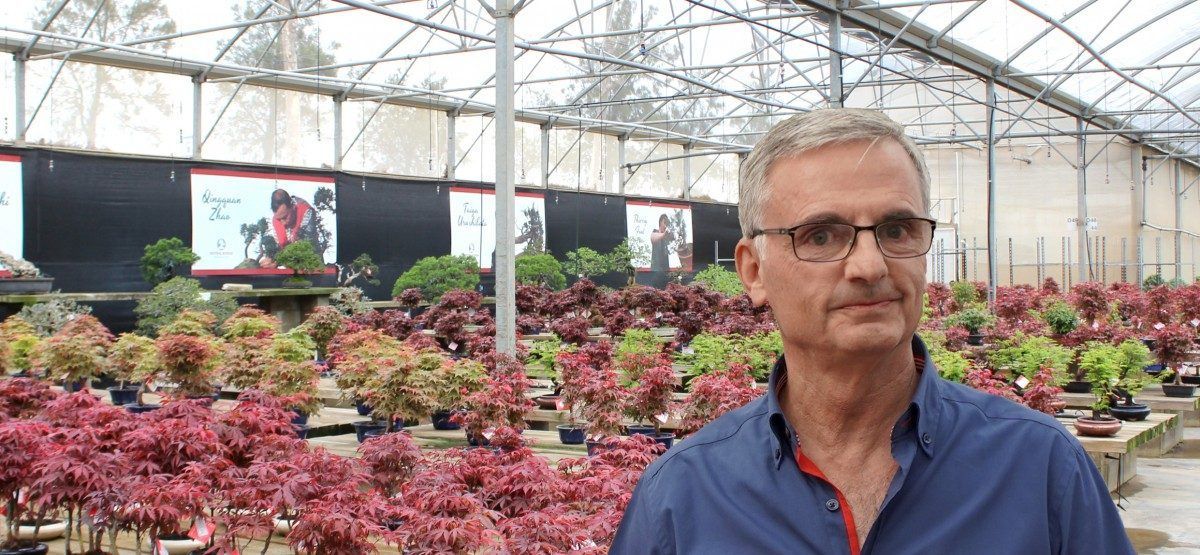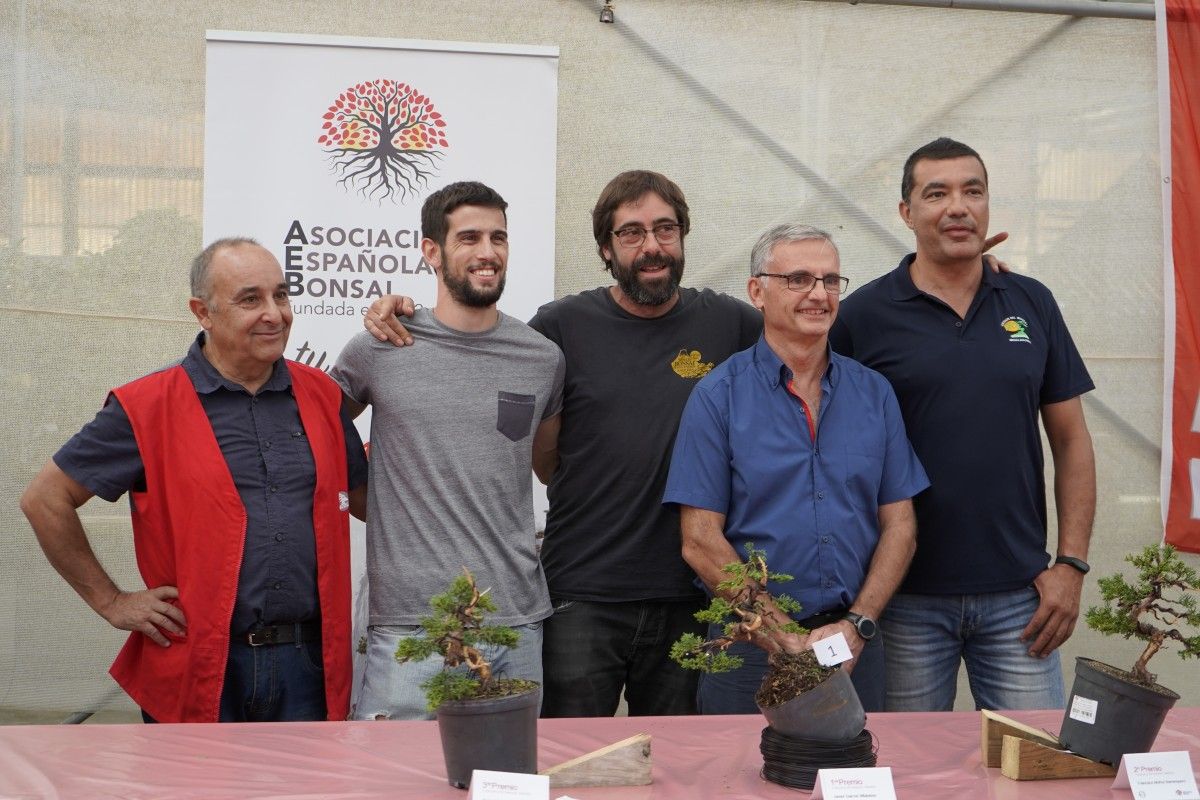“Spanish bonsai is number one in Europe”

Juan Gómez grew up in a mountain town surrounded by trees and nature. This is how his passion for bonsai was born, more than 20 years ago. He’s got a large collection of bonsai that he pampers every day, enjoying each task. Today he is the current president of the Spanish Bonsai Association.
Saturday, October 5, 2019, at the Open Days, we had the pleasure of chatting with him for a while and asking him some questions. Would you like to learn about this lover of the world of bonsai?
What is the Spanish Bonsai Association (AEB)?
The AEB is an association created in 1982. For many years, it has been the only national association in Spain. In turn, it also became co-founder, with 4 or 5 other countries, of the European Bonsai Association. It is practically the oldest national association in Europe.
How do you see the future of bonsai associations in Spain?
I see the future as promising. In fact, in recent years, there is a boom in terms of the emergence of new associations. More and more bonsai fans are joining associations. Formerly it worked more self-taught. Each one went on his own and it was very individual.
Do you think we are at the same level of maturity as other countries in Europe?
Maybe this is not for me to say, but the level of the Spanish bonsai is possibly number one in Europe. We can find Spain in the first position of most of the renowned exhibitions in Europe.
What are the advantages for an amateur of joining an association?
I recommend to any amateur to join and participate in the associations. In an association you will always find support. You will be able to share knowledge with more experienced fans, that will be very helpful. Among the amateurs there are different levels, and there is always someone who goes one step further, showing you the path and thus can help you with things that, on your own, could have taken a long time to discover.
Lately, there has been a growing bonsai movement in Spain, have more new associations been created? How many bonsai associations are there currently in Spain?
The number of associations that exist is difficult to say. As associations of national level, for many years, there has only been the AEB. Two others have appeared in recent years, so there are now three national associations. And then there are provincial and local associations. There are many and it is difficult to quantify because there are some that are not registered as such. Anyway, it is a group of amateurs who have joined, they have a place and they meet on specific days, and although they are not officially registered, they are associations. So it is very difficult to determine how many there are today. What is clear is that there is more and more and it is growing.
What actions do you think are necessary to improve the level of our fans?
The associations are the ones that are carrying out these actions. An example is the amount of local, provincial, national exhibitions that are taking place. For many years there have been many less. The increase in associations is promoting bonsai because it makes it known by people who before did not have access to it. We can say that the bonsai in recent times is booming thanks to the work of dissemination of this art, especially carried out by associations.
In recent years, more Mediterranean varieties, perhaps less common in Japan, are appearing. How do you see this trend?
Yes, it’s correct. In recent years, the concept of a Japanese tree has triumphed. In the exhibits there were practically only Japanese varieties. In recent times, native Mediterranean trees are showing. In renowned contests you can already see magnificent results. It is a bonsai that a while ago, it is not that it was not valued, but it was a little more on the back burner, and now it is already at a very important level. There are specimens competing in competitions that are very well placed and very well valued. We value Native bonsai less, perhaps because we see it as something more common. But possibly, in other non-European countries, they would value it more than we do.
This weekend we have celebrated the New Talent Contest organized by the AEB in Mistral Bonsai’s facilities, a contest that appoints the Spanish representative for the European competition. What would you say to a bonsai fan to encourage him/her to participate next year?
I would say that it is a unique experience to participate in a national competition. The prize is to represent your country in the European congress, and you will also have the opportunity to meet fans from different places. When you talk to participants from other years, they would participate again. It is a unique experience, being winner or not. There is only one winner, but all the participants come back having gained very enriching experience.
In 2020, where will the contest be held?
At AEB we are working for the next congress. We spotted some possible cities, but we are still assessing where it will be held.
Let’s go back to the New Talent Contest that has been held this weekend. The New Talent of Bonsai 2019 has been Javier García Villalobos. We have seen the trees of the participants and it must be very difficult to choose the winner, since the level was very high. What elements of the winning bonsai have made the jury decide?
The jury has valued several things of bonsai. One of them has been the design that has been made in this tree and another also very important, the definition and finishing of the tree. The delicacy of the branches.

Nowadays, feminism and empowerment of women are booming. The world of bonsai is traditionally a very masculine world. This year we have seen two women participating in the contest. How do you see the role of women in the bonsai amateurism ?
Well look, when we talk among male fans, practically most of us ask ourselves, why don’t women participate more? We do not understand why. Women have, what we commonly think, a subtlety and finesse that many men don’t have. In matters of botany and gardening, women do very well, however, we find very few women in the world of bonsai. And what we want is to encourage the entry of women into this art.
How does AEB participate in this change?
I think it was the first time that, of all the participants, there was two women. They were both very excited, just as we were, about their participation. They have a spectacular level.
What young promise do you think we should be attentive to and follow?
It would be complicated to give a name. Of the last year selected New Talents, there are some that are already standing out and doing very good works. They have an excellent progressive level. And about this year, the level of participants has been very high. I was very surprised by the level of quality in the work done. So we should be attentive to the evolution of any of the firsts classified. There may even be someone who hasn’t done his/her best work today. There are people who, with the pressure of working a tree in a limited time and facing the public, are a little more pressured, and the work they are capable of, at that time, they don’t manage to show it. But the more they will perform public works, the easier their inside knowledge will show.
What are the next activities of the AEB?
The main activity is the next national congress that we are organizing. As previously said, we are waiting to choose the city where it will be held and this is our main objective.
What would you say to a person who is starting this hobby?
This question seems very interesting to me. There are many people who start and leave, they stay halfway. One of the reasons is that they see it too difficult and complex. I always tell them that it is not so much. Reaching a Master level is perhaps more difficult, but being a good bonsaist is not as difficult as it seems. In the beginning, one can always have some loss of a bonsai. Something as elementary as doing a transplant, watering … are very basic things but that you need to master to move the tree forward. If you don’t move, you get bored and leave. Now it happens less because, as said before, with associations it is easier. They will advise you on the basics, they explain what needs to be done to keep the bonsai alive. When you go self-taught, you may not know how to do, for example, a transplant. I would ask any amateur to rely on people who can help them, because we can ensure that it is not as difficult as one thinks.
About the Author
Mistral Bonsai
In Mistral Bonsai we are a communication team, technicians and masters committed from the first day to disseminating the wonderful art of bonsai. A world that offers many things to share. We believe that a bonsai is a tree with a soul, unique and unrepeatable. Another of our most essential pillars is, how could it be otherwise, our close commitment to the preservation of the environment and nature.
Categories
Bonsai cultivation and care (54)
Bonsai gift (2)
Bonsai pests and diseases (6)
Bonsai repotting (3)
bonsai substrates (2)
bonsai tools (1)
Bonsai work (10)
Ceramic pots (3)
Chinese culture (2)
Chinese culture (1)
Corporative Mistral Bonsai (8)
Cuidados del bonsái (22)
Cultivo del bonsái (20)
Dead wood (2)
